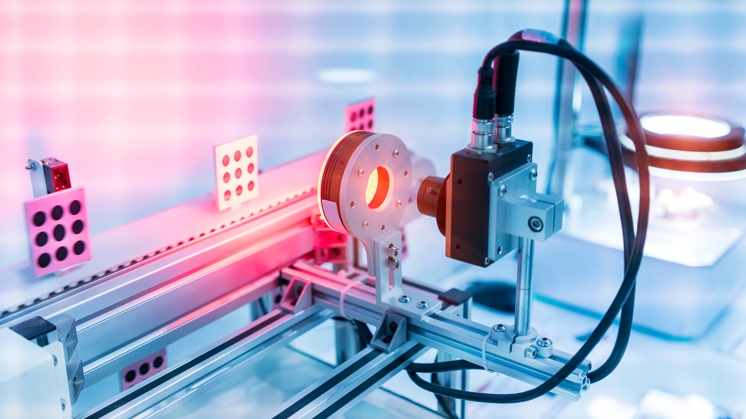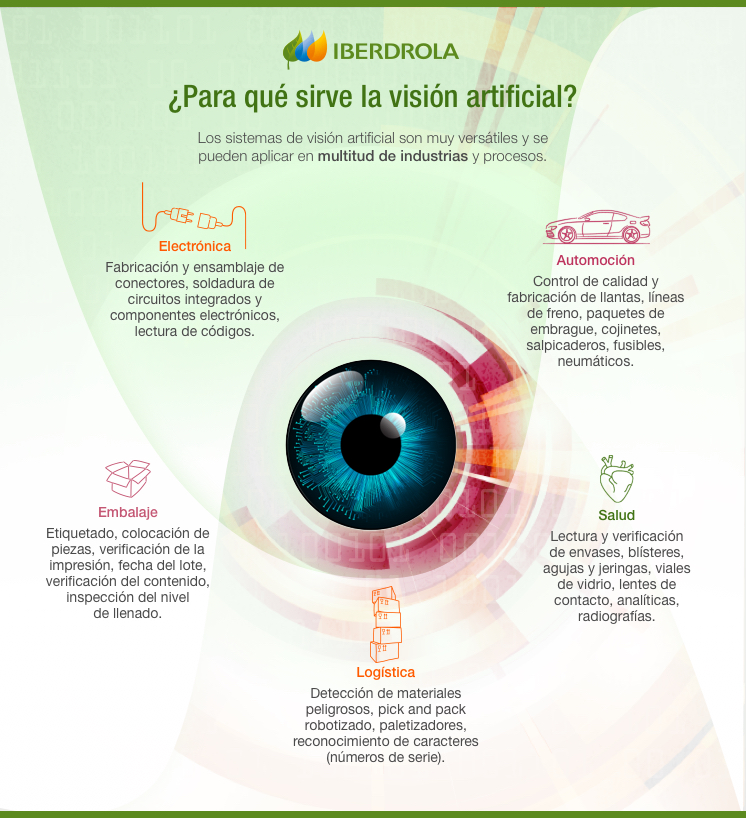Vision Artificial
¿Qué es la visión artificial y cuáles son sus aplicaciones?
Los seres humanos utilizamos nuestros ojos para comprender el mundo que nos rodea. La visión artificial es una disciplina científica que persigue que los ordenadores alcancen esa misma capacidad, es decir, trata de conseguir que las máquinas puedan percibir y comprender una o varias imágenes y actuar de una manera determinada. A continuación, repasamos algunas de sus aplicaciones.

El cerebro humano recibe constantemente información de su entorno a través de los ojos y somos especialmente sensibles a los cambios repentinos de luz y tamaño aparente de los objetos, lo que nos indica que algo se mueve a mucha velocidad y nos permite, por ejemplo, agacharnos en una fracción de segundo para esquivar un balonazo. La visión artificial es la tecnología que permite a los ordenadores tomar decisiones a partir de unos pocos datos visuales con la misma rapidez.
QUÉ ES LA VISIÓN ARTIFICIAL
Según la Automated Imaging Association (AIA), la visión artificial engloba todas las aplicaciones industriales y no industriales en las que una combinación de hardware y software proporciona orientación operativa a los dispositivos en la ejecución de sus funciones basándose en la captura y el procesamiento de imágenes.
La visión artificial no debe confundirse con la visión por ordenador, aunque la diferencia es sutil. Esta última se centra en comprender las imágenes digitales después de procesarlas y analizarlas, es decir, de extraer todos los detalles posibles. Por el contrario, la artificial no necesita analizar todos los detalles de la imagen, sino solo aquellos que impulsen a realizar una acción determinada. Por ejemplo, la visión artificial de un coche autónomo solo se preocupa de detectar obstáculos para evitar colisiones.
La visión artificial en la Industria 4.0
La Cuarta Revolución Industrial mezcla vanguardistas técnicas de producción con sistemas inteligentes que se integran en las organizaciones. Entre las innovaciones tecnológicas que se aplican a la fabricación para hacerla más eficiente se encuentran la hiperautomatización, el big data, el Internet de las cosas, la robótica o la realidad aumentada. La visión artificial, muy relacionada con tecnologías como la inteligencia artificial o el machine learning, también será un componente esencial para el futuro del sector industrial al permitir, entre otras cosas, descubrir fallos durante la producción o identificar productos defectuosos.

SISTEMAS DE VISIÓN ARTIFICIAL
Un sistema de visión artificial consta de varios componentes, desde la cámara que capta una imagen para su inspección hasta el propio motor de procesamiento que renderiza y comunica el resultado. A continuación, los repasamos en detalle:
- Sensores de visión: incluye los diferentes tipos de cámaras y sensores de luz en todas las frecuencias, sensores 2D y 3D.
- Cámaras inteligentes: además de los sensores, incluyen un procesador capaz de analizar las imágenes y proporcionar resultados con los que tomar decisiones.
- Sistemas de visión avanzados: son los dispositivos, por ejemplo, los cobots, que integran los sistemas de visión artificial para realizar tareas específicas.
CÓMO FUNCIONA UN SISTEMA DE VISIÓN ARTIFICIAL
Para que un sistema de visión artificial funcione correctamente es necesario que se cumplan una serie de condiciones y requisitos:
Iluminación
La luz debe ser regulada y constante para que los cambios de luz captados por el sistema de visión artificial se deban a cambios en los objetos inspeccionados y no a cambios en la fuente de luz.
Puesta en escena
Es un proceso mecánico que consiste en colocar el objeto a examinar delante de la cámara (puede haber sensores fotoeléctricos que indiquen si el objeto está correctamente situado).
Cámaras
Las usadas para visión artificial son especiales y más costosas. Por ejemplo, es deseable tener píxeles físicos cuadrados para poder tener medidas más exactas, así como obturadores avanzados.
Procesador de imagen
Se puede realizar desde un ordenador conectado a la cámara o desde la propia cámara si se trata de un modelo inteligente capaz de analizar la imagen y proporcionar un resultado por sí misma.
Comunicación
Los sistemas de visión artificial están conectados a otros sistemas, como los de gestión de inventario, control de suministros o inteligencia de negocio.
BENEFICIOS DE LA VISIÓN ARTIFICIAL
La aplicación de sistemas de visión artificial en los procesos de fabricación tiene una serie de ventajas:
- Precisión: aumentan el nivel de precisión durante la fabricación y eliminan los errores humanos.
- Calidad: garantizan la máxima calidad y que los productos cumplan con las especificaciones.
- Rentabilidad: aumentan los beneficios y reducen los gastos generales, ofreciendo un alto ROI.
- Sostenibilidad: permiten fabricar productos ahorrando recursos y reduciendo los desperdicios.
- Monitorización: facilitan el diagnóstico y la resolución de problemas durante la producción.
- Seguridad: mejoran la seguridad y la protección en entornos peligrosos para las personas.
APLICACIONES DE LA VISIÓN ARTIFICIAL
Los sistemas de visión artificial tienen numerosas aplicaciones y, a continuación, repasamos algunas de ellas:
- Detección de objetos: comparación de una imagen con patrones conocidos y almacenados en una base de datos para detectar objetos, incluso si están parcialmente ocultos.
- Reconocimiento óptico de caracteres (OCR): un proceso dirigido a la identificación automática de símbolos o caracteres en una imagen para luego almacenarlos en forma de datos.
- Robots con visión artificial: reduce o elimina la necesidad de colocar las piezas en sitios fijos para que los robots las manipulen, ya que son capaces de localizarlas y colocarlas por sí mismos.




